Critical Management Strategies for Dormant Season Grazing During and Following Drought
Take steps to manage the limited forage you have this fall and winter. The right choices not only sustain your operation, but also ensure the health of your rangeland long term.
Looking ahead to winter grazing and feeding after a second dry year is no rancher’s idea of fun. Yet, look ahead we must, for the good of the herd and our rangeland.
In 2021, severe drought dried up forage and drove reductions in hay stores, forcing 40% of farmers to liquidate a portion of their herd. Conditions aren’t much better this year, with almost 40% of the Lower 48 states experiencing drought. Add in poor range conditions and rising feed costs (up nearly 15% from 2021), and ranchers are facing exceptional challenges when it comes to managing dormant season grazing.
With the right strategies, however, we can manage the forage we have, ensure the long-term viability of rangeland and, most importantly, sustain our operations and margins. Remember, it’s not about yield or the number of cows you have at the end of the year. It’s about profit per acre. Even in a dry year, you can still boost your bottom line with good management and early planning.
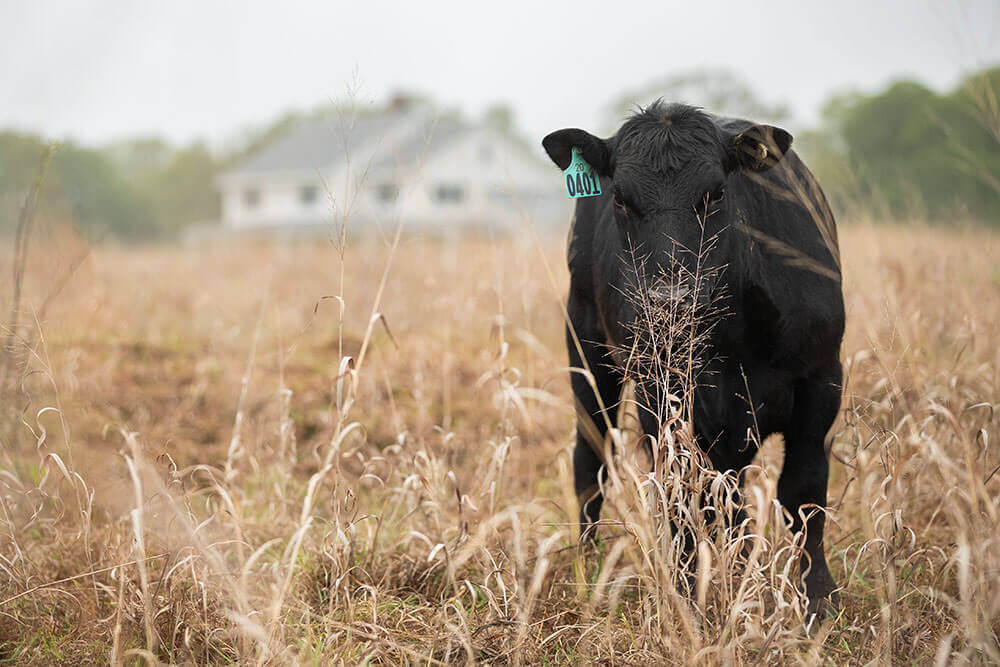
First, Take Inventory of Your Forage
Moving into winter, you need to know how much forage you have and what you’ll need to get through to next season. Ideally, you want enough residual to last 30 days into spring so that any pastures grazed in late summer through winter have time to regrow and come to a full flush. If you graze new-growth grass too early, cattle consume forage that’s full of water and high crude protein, but low in structural carbohydrates, and therefore provides minimal gain.
To estimate forage inventory, first calculate your forage demand and reserve herd days. Reserve herd days are the number of days your existing total number of cattle (herd) can graze on existing forage reserves, including standing pasture, and stored forage such as hay – total grazeable forage for existing herd of cattle.
A mature, 1,000-pound cow will graze about 26 pounds of forage a day – so err on the conservative side and estimate 30 pounds per head, per day. If you have 100 cows needing 30 pounds of forage a day, you’ll need enough inventory to meet 3,000 pounds of forage (i.e., the equivalent of approximately three round bales) per day. If cattle weights vary much from 1000-1100 pounds, then simply multiply their average weight by 3% to determine per-head per-day forage demand.
You want to ensure that you’ve got enough reserve herd days available while also allowing for good residual after grazing to preserve your pastures.
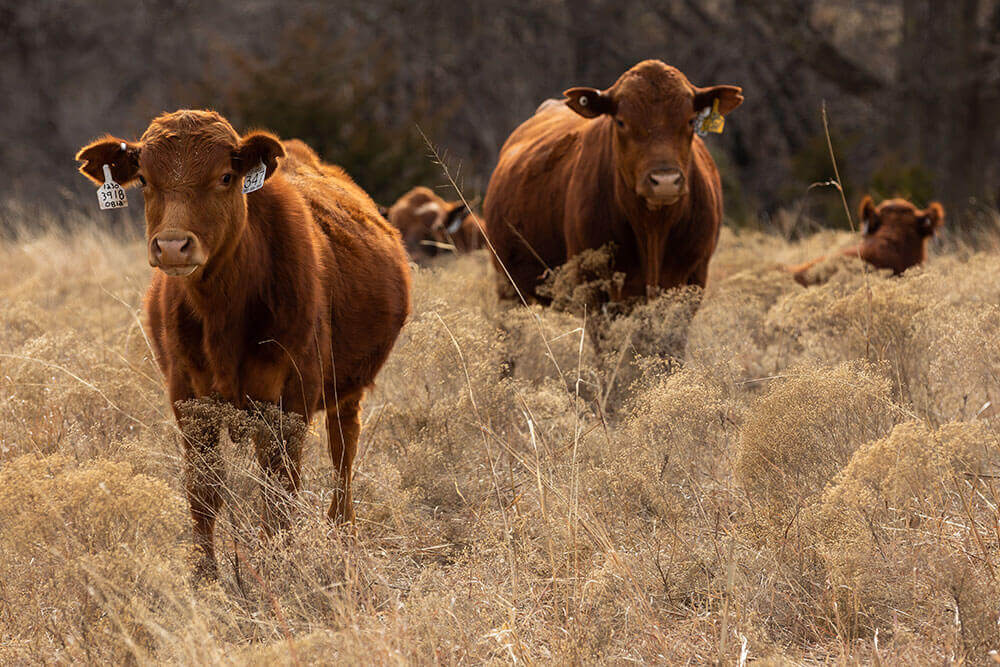
How to Measure Forage by Acre
- An easy way to assess pasture inventory is to estimate bales per acre if hayed. For example, if your pasture would make 2.5 bales per acre and bales weigh about 1000 pounds each, your forage inventory adds up to about 2,500 pounds per acre. Multiply that by grazing efficiency to measure total forage inventory. The appropriate grazing efficiency for native pasture is 25% of production; 50% for introduced pastures (like bermudagrass) at full recovery.
Pasture total forage inventory X Grazing efficiency = Grazeable forage inventory - Next, determine the difference (or surplus) between the forage demand of your existing herd and grazeable forage inventory (plus any stored forage/hay reserve).
Forage demand – grazeable forage inventory (including reserve) = Total forage deficiency or surplus - Based on total grazeable forage inventory you will know if and to what extent you need to reduce your stocking rate.
With Rotational Grazing
If you are using rotational grazing, it’s easier to measure total forage inventory.
- Determine total days of grazing your herd needs from now until spring (making sure to account for 30 days into spring). For example, the period from Oct. 1 to May 1 is 210 reserve herd days needed for existing herd.
- Determine total days your herd can graze in each pasture, assuming no additional growth, and then add all the pasture totals plus days of stored forage to compute your total reserve herd days.
- If your total reserve herd days for grazing fall short of what’s needed by the herd, you’ll have to reduce your stocking rate to compensate for the deficiency in grazing or forage. For example, if you only have 150 reserve herd days (including hay), then you need to reduce your stocking rate by 29% (210-150/210).
Regardless of your grazing method, please note that feeding hay through a drought is not recommended. If you’re routinely feeding hay to cattle on native rangeland — no matter the time of year — you’re already overstocked.
Balance Stock and Forage Inventory
What if your reserve forage and livestock inventories don’t balance? On rangeland, you’ll need to destock and reduce your herd to match the amount of reserve forage inventory. If you’re fortunate to have access to cropland, you may have other options (as explained later).
Move to Managed Grazing
Once you balance stock and forage inventory, it’s time to allocate the forage you have – and that’s where managed grazing comes in. For maximum efficiency, allow no more than 1 or 2 days of grazing per grazing event or paddock – ensuring that your herd doesn’t graze below the optimal residual height (see “What’s My Optimum Residual” sidebar). You cannot graze that same pasture again until after full expression the following spring.
Moving a herd daily can improve grazing efficiency in a pasture by 30-50% over continuous grazing (depending on the year).
- With managed grazing, you are in control, giving cattle those 1- to 2-day allocations. Used year-round, managed grazing can help you better understand the balance between reserve herd days and livestock inventory, and play a more active role in sustaining residuals.
- With continuous grazing, cattle eat the desired plants upfront and then continue to regraze those plants, which does not allow recovery.
Knowing available grazing days relative to herd size also allows for greater flexibility and opportunities when it comes to marketing. By knowing monthly forage production, you can better manage your marketing, better sustain your pastureland and get down to profitability. Those goals should always take priority over retaining stock.
Stocking rate should always be dictated by forage production. By operating with a more conservative stocking rate, you can retain calves or bring in more cattle during the good years, and more easily make stocking decisions during drought. Don’t be married to the cow. Too often ranchers consider a cow an asset – like a factory – that depreciates over 5 to 7 years, and are reluctant to destock her prematurely. But running a factory that becomes short-supplied can shut the whole thing down.
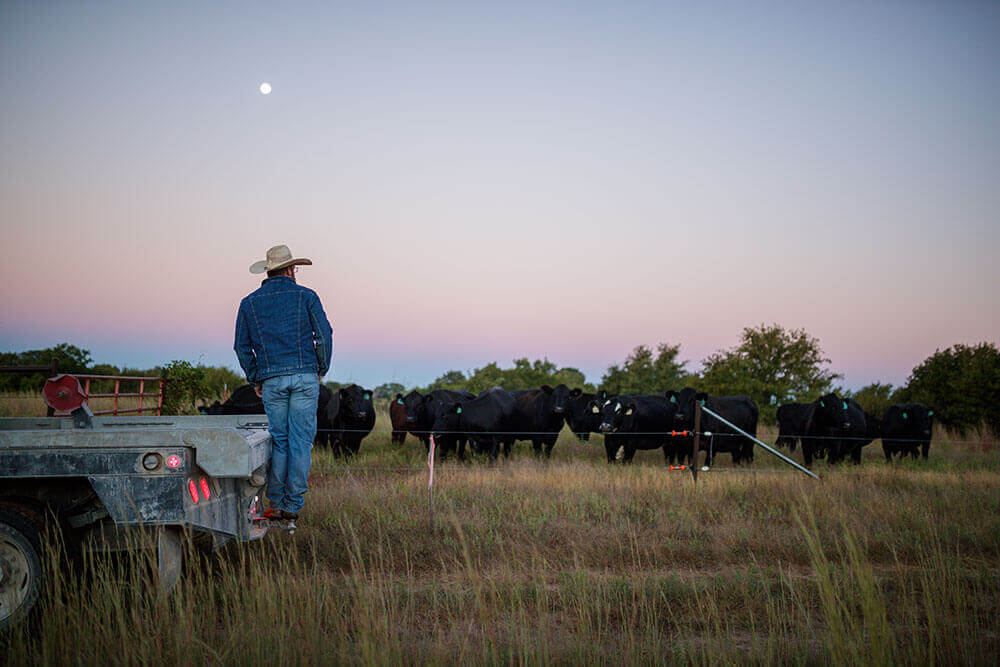
What’s My Optimal Residual?
Target residual will depend on your region’s annual average rainfall. In lower rainfall environments, retain a greater percentage of annual production as residual, especially during drought. For example:
- At 20 or less inches of rainfall and 1,000 pounds-per-acre production, target 75% production for residual forage (usually native range).
- At 35+ inches of rainfall and 3,000 pounds-per-acre production, target 50% production for residual forage on introduced pasture and 75% for native range.
Arid regions require more residual in proportion to the amount of forage that’s grown, as more rainfall in a wetter region brings more organic plant material and faster plant decomposition.
The grass in your pasture will determine desired residual height, regardless of the time of year:
- For tall grasses (e.g., little bluestem, big bluestem, switchgrass), residual height should be about 6 to 8 inches – allowing cattle to eat the leaf portion and let the plant maintain the reproductive tissues.
- For mixed or shorter grasses (e.g., dropseeds, sideoats grama, other grama grasses, cereal grasses), cattle can clip the leaves but not eat the stems. Never allow the animals to take more than the top 30% of the plant.
Don’t Risk Your Residual
Never underestimate the importance of maintaining healthy residual – and the negative impacts of overgrazing – particularly in more arid regions and under drought conditions. In addition to allowing higher erosion and moisture evaporation, bare soil lacks the plants, organic surface material, and soil organic matter necessary to infiltrate and capture water. Letting your cattle overgraze removes the plant residual and litter that are key to recovery.
It takes grass to grow grass and maintain a healthy successional state.
Managing for residual also impacts range and pasture resilience. An overgrazed pasture can take three to five years of good management to grow back in regions with more favorable rainfall, and 10 or more years in more arid regions. By managing for more plant residual through drought (especially of the deeper-rooted native grasses), you can actually improve your range condition when sufficient moisture returns.
Managing what your animals graze is also critical and can increase total forage production. By select top-grazing in the spring — once the grasses express “full-flush” conditions and are actively growing — you can trigger tillering and boost new tissue growth. Past mid-summer and the equinox, grasses will not tiller as much because many of the native plants are going reproductive.
Fortunately, with proper management, rangeland actually can rebound faster and better after drought. Producers who destocked early, maintained healthy residual and allowed for full flush in spring often see a 15-20% increase in forage production in just two years with favorable weather. The key here is managing residuals and remaining conservatively stocked or even understocked until you have evidence that your grass is beginning to thrive.
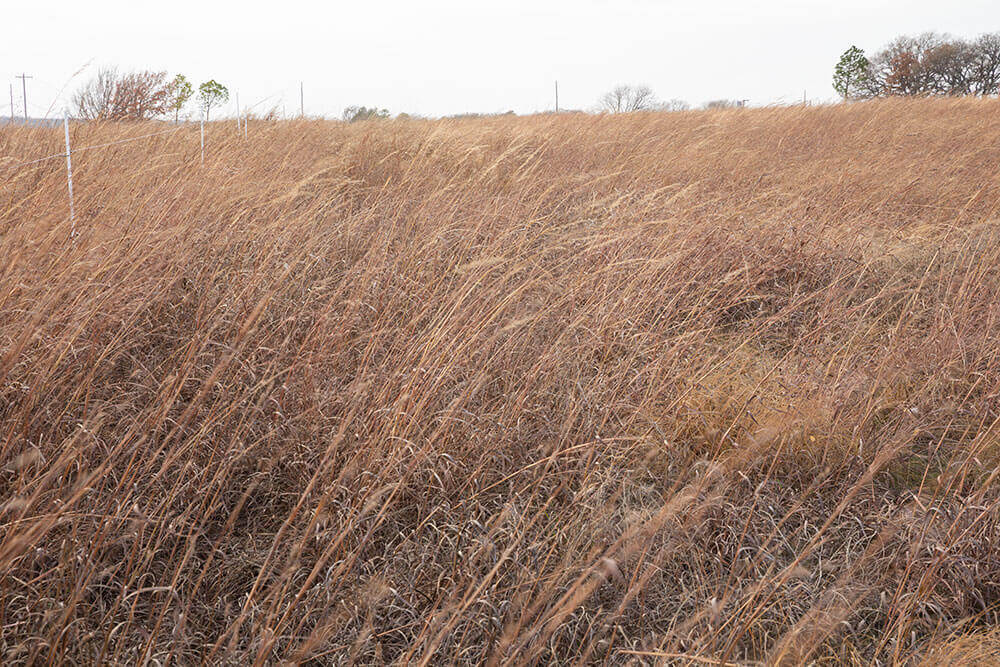
Tap Your Introduced Pastures and Cropland
If you have introduced pastures or cropland, you have backup forage options. While introduced pastures or cropland must be managed in much the same way as rangeland, they can be more forgiving if you’re willing to invest in inputs. You can grow forage by interseeding annuals (e.g., cereal rye, oats or wheat, or a good mixture with legumes, hairy vetch and clover to bring spring on early) behind what you graze. By springing early with cover crops on introduced pasture and croplands, you can graze the cool-season forages well into spring and allow your perennial native pastures more time to reach full expression and recover before grazing.
It’s important to plan for these opportunities now to take advantage of what additional forage they can produce – either by taking advantage of timely rains in the fall to grow forage by November/December or spring rains for early spring forage.
A Noble study showed that a mature cow can graze small-grains pasture (i.e., wheat, cereal rye) just 15 minutes a day and still meet all her supplemental protein needs (45 minutes to one hour of daily grazing if she’s lactating). You can supplement a lower-quality dry-matter diet (for example, standing, dormant forage or corn stalks at a neighboring operation) by limit-grazing the small grains pasture.
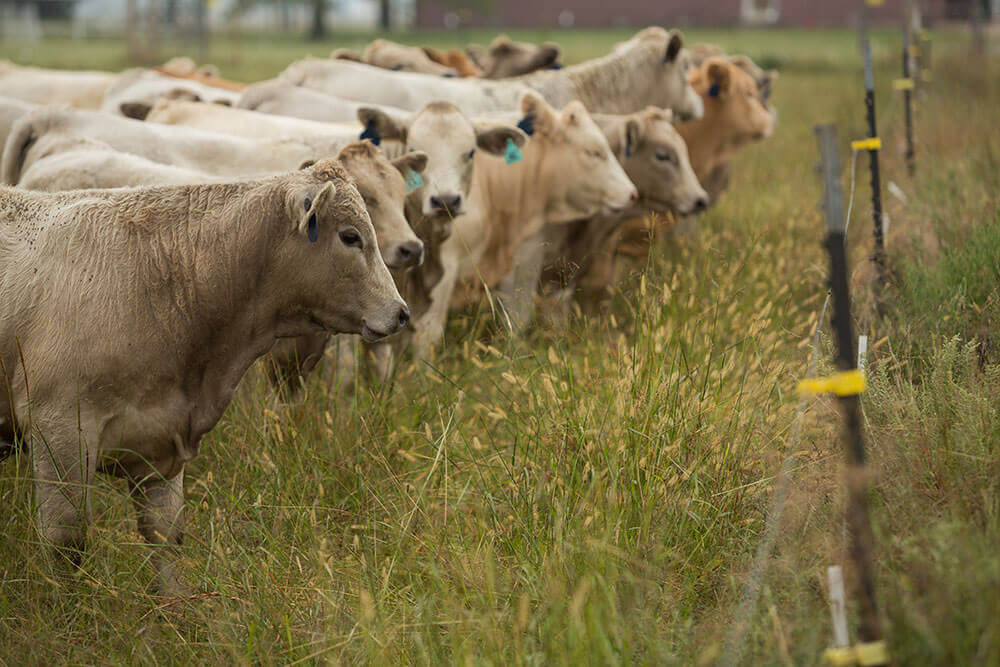
Always Look Ahead
The time to plan for a drought is when it’s raining, and the time to plan for rain is in a drought. The better we can manage our lands, the more rapidly we improve our soil and ultimately the more resilient our grazing land becomes. It all starts with managing the residual above the soil with managed grazing.

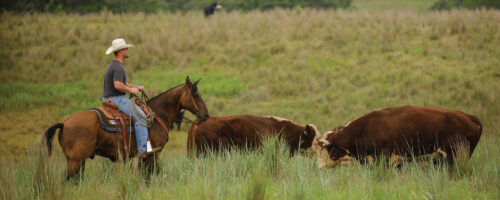
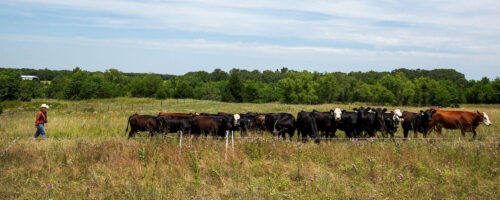
Comment